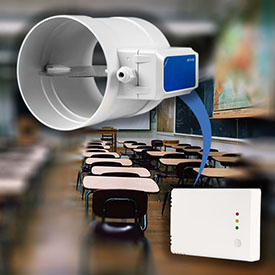EU declaration conformity
CO2 controller | wall mounting | LED indicators | 24 V DC
Product description
Single-output temperature, humidity, and CO2 controller. The supply voltage is 24 V DC. Temperature, relative humidity, CO2 (carbon dioxide), and ambient light are all measured. This sensor controller regulates ventilation systems and controls fan speed in commercial and residential settings.
Based on the measured values, the sensor algorithm controls the single analogue output. This single output can control an EC fan, an AC fan speed controller, or a damper actuator directly. The output type is set to 0-10 V by default but various output types are available. Modbus RTU allows access to all measurements as well as the output value.
The CO2 sensor element can be replaced. The ambient light sensor can be used in many applications to control the ventilation system based on the occupancy of the room. Modbus RTU can be used to change all of the settings. The light intensity of the LEDs used for status indication can also be adjusted.
Documents
Additional specifications and description

The ABC logic self-calibrating algorithm is by default enabled. This algorithm is designed to be used in applications where CO2 concentrations will drop to outside ambient conditions (400 ppm) at least once (15 minutes) in a 7day period, which is typically seen during unoccupied periods. The sensor will reach its operational accuracy after 25 hours of continuous operation at a condition that it was exposed to ambient reference levels of air at 400 ppm ± 10 ppm CO2.
The enclosure offers an IP30 protection against ingress of dust and moisture. It can be mounted on a wall indoors. To ensure optimal performance, it should be protected from direct sunlight.
∞ Monitoring air quality







.webp)
.webp)
.webp)
.webp)
.webp)
.webp)
Remarks, reviews & ratings